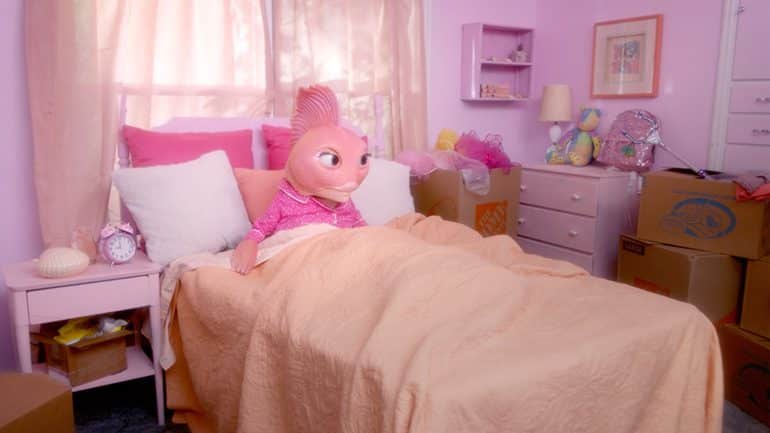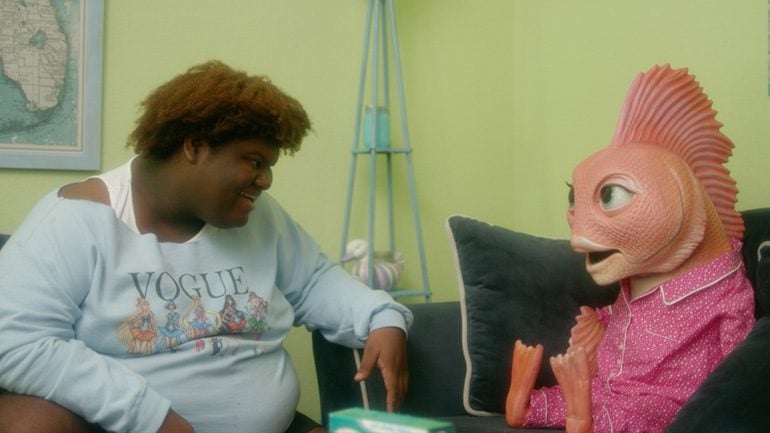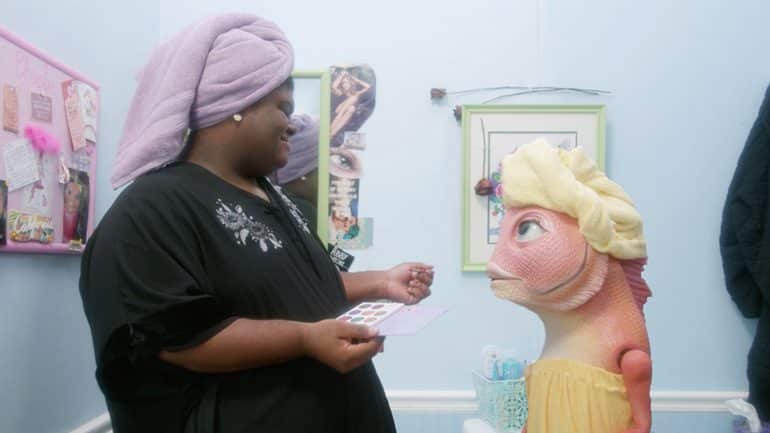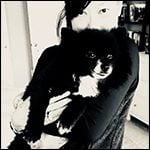With a dad in special effects makeup, blood and guts became a normality for Kyra at a young age. Combat nursing was her first goal, but she soon discovered that real blood is way grosser than the fake stuff. Since high school she’s been pursuing a career in directing and plans on creating quirky fantastical films from the lore of her unconventional childhood.
StudentFilmmakers Magazine: What was one of the most important things you learned while directing your short comedy film, “Phoebe”?
Kyra Gardner: I think one of the most important things I learned is that directing a puppet is a lot more work than it looks like. A puppet has only so many movements and it has limitations. You really need to storyboard out almost the entire movie beforehand in order to be able to communicate with your crew what is happening. Over the years, I have learned people have a harder time grasping fantasy concepts, so storyboards aren’t just there for yourself and your puppeteers, but also to help the crew understand what is happening when they don’t understand why there’s a fish in a toilet bowl crying. Rehearsals are incredibly important and run through something like this, and I only had one day to rehearse with my entire ensemble. I wish I had had more time but going forward I know that’s definitely something that should be given more attention to.

StudentFilmmakers Magazine: The main character, Phoebe, is amazingly an animatronic puppet. Can you tell us about how you directed scenes with Phoebe and actress Kimmy Robertson, Phoebe’s voice?
Kyra Gardner: Kimmy Robertson was such a dream to work with on this project. The process was having her initially record the lines, then having the puppeteer controlling Phoebe’s mouth mimic how Kimmy said it, and then Kimmy mimicked the puppeteer for the final voice over. I filmed Kimmy’s initial read-through of the script to see what movements she initially had as a part of the character. So on set we could try and mimic her motivated movements. It’s very different directing a puppet rather than a person. As all three people, sometimes four, operating Phoebe are trying to physically show an emotion through movement. It felt a little weird to not talk with an actor through the emotions of a scene and rather speak with three individuals on how we can physically and collectively work to show those emotions. It was definitely a challenge.

StudentFilmmakers Magazine: What were some challenging problems solved during pre-production, production, and post-production?
Kyra Gardner: Pre-production was intense and fast. Our school didn’t provide too much pre-production time, so I had to commit to ideas while writing the script and some things couldn’t change. I had to decide on Phoebe being a fish pretty much during the first draft in order for her to be built in time. With the help of Alterian, we went through a few small-scale iterations of her look and then decided on something final that was sculpted life size, casted, and then created with foam and plastic with the animatronic wires running through the inside. However, creating the world for her was the ultimate challenge in pre-production. I wanted to create a Wes Anderson-y world that was real but looked fantastical. Phoebe’s world and color palette was brighter and warmer, consisting of pinks, yellows, and oranges. From the paint of her scales to her wardrobe. Then her surrounding world is all consistent with cooler tones like blues, greens, and purples. Making it so physically and visually she did not fit in with her environment. I ended up painting my own living room green, a friend’s spare bedroom pink, rotoscoping houses to be different colors, and painstakingly picking out wardrobe that were specific colors. And due to any bathroom being too small to film in for our crew and a puppet with three people attached to her, we had to build a bathroom set from scratch. My production design team worked so incredibly hard on that and basically learned how to do it off of YouTube. I am so grateful for them and all their hard work. It was incredibly difficult to do with the couple weeks of time we had, but I was so happy with everything turned out.
As many people say, the biggest challenge on set was time. We only had three days allowed by our school to shoot the film with eleven scenes, nine different locations, and over thirty actors to wrangle. We were constantly racing the clock and Phoebe herself was no help. She had to move in specific ways in order for myself to be able to do the special effects required to remove the puppeteers from the frame. And sometimes she would malfunction and need to power off and back on. I wish we had more time, but thankfully, with all the work put in during pre-production – like storyboards, photo boards, and location scouts – we were able to get what we needed.
Post-production was also a challenge of course. There were about thirty visual effects shots needing to be finished in order to remove the puppeteers, or to enhance colors on screen. Thankfully we mostly locked off our shots in the film so that the VFX work would be a lot easier than trying to work with moving footage. I wasn’t too skilled in visual effects and had injured myself after shooting the project, so I ended up doing most of the post work in a foot cast. But thanks to some help from some classmates, I was able to finish everything.

StudentFilmmakers Magazine: If you could share your Top 3 Film Directing Tips for student filmmakers and aspiring film directors, what would they be?
Kyra Gardner: I would say that something is always going to “go wrong” in some way on set. It rains, an actor is late, a prop is forgotten, etc. Especially on student films. No matter how hard you prepare or stress for a film, something is going to create a hiccup. Protect your mental health and don’t go insane over it. Being able to remain calm and adaptable on set is everything, and your crew will follow that mind set and create a positive atmosphere.
They say your story goes through three iterations. Once when you write it, when you film it, and then once you edit it. Make sure you get some variety in your performances on set even if you don’t think you’ll need it. Because certain things may change if they don’t seem to be working when you’re in the editing room and having that variety can be a life saver.
It sounds cliché but listen to your gut. I was told by multiple professors that several of my films weren’t going to work while in school. I had a very different style to most students, and it made it hard for some people to wrap their heads around. I constantly battled with some faculty to be able to pursue my ideas, and I’m glad I didn’t back down. I was confident that it was going to work and that I knew what I was doing. Believe in yourself and trust your gut – even when it seems like the world is telling you no.

 Interview conducted by Jody Michelle Solis. Associate Publisher for StudentFilmmakers Magazine (www.studentfilmmakers.com), HD Pro Guide Magazine (www.hdproguide.com), and Sports Video Tech (www.sportsvideotech.com) Magazine.
Interview conducted by Jody Michelle Solis. Associate Publisher for StudentFilmmakers Magazine (www.studentfilmmakers.com), HD Pro Guide Magazine (www.hdproguide.com), and Sports Video Tech (www.sportsvideotech.com) Magazine.
“Lifelines, not deadlines. Motion Arts. Fusion Everything.”
I aim to create an award winning student film as well when I will graduate. So inspiring to see someone who made it!
I can see the passion and dedication in her eyes. She truly worked very hard!
What a lovely story! I wonder what other lovely projects did she do since she graduated